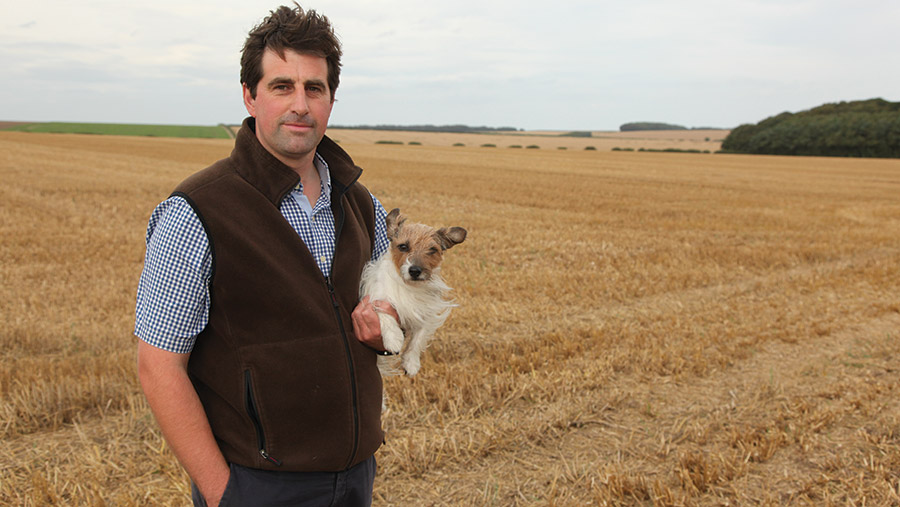Driver’s view: James Grandy’s Amazone drill

Yorkshire farmer James Grandy runs through the good and bad points of his Amazone Cayena drill and how it has slotted into his establishment system.
What drill are you using?
We have a 6m Cayena 6001 tine drill, which arrived on the farm in 2013. It has a 3,600-litre, grain-only tank, which takes about 2.5t of wheat seed.
It also has track eradicators, pre-emergence markers and auto shut-off, which runs through the Amatron 3 control box in the cab of our main tractor.
See also: Driver’s view: John Hawkins’ Simtech T-Sem drill
Why did you change to a strip-till drill?
Before we bought the Amazone, we were using a 3m power harrow-drill combination and it was quite slow.
We wanted to speed up the drilling operation and went for the Cayena, as it doesn’t take much pulling and can be driven at high speed.
Farm facts
- Moor Farm, West Heslerton, Yorkshire
- Size – 365ha
- Soil – Stony chalk
- Crops – Winter wheat, winter barley, oilseed rape or winter beans and potatoes (rented to third party)
Now, once the soil is prepared, it doesn’t take us long to get across the ground.
The tine drill is also more suited to our stony Wold soils than the previous machine.
How does it work?
It has 36 narrow tine coulters on 16.6cm spacings, arranged in three offset rows.
Seed is dropped down just behind the tine and the raised protrusions on the pneumatic wedged ring tyre roller are aligned with each tine to consolidate the seed slot.
It also has a following harrow to help leave a level finish.

The drawbar sits on the bottom link arms and the rear roller when in operation, with a pair of guide wheels on each wing at the front of the frame.
Each tine is rubber sprung, which helps the drill follow contours and also acts as protection from stones.
Depth is fine-tuned by a ratchet spindle on the end of each wing.
How has it performed?
We use the drill on prepared ground.
It usually has one or two passes with a Horsch Terrano, then we run through with a 6m Great Plains press just ahead of the drill to level the ground and take any remaining clods out.
We see very even seed depth and emergence, even on the stonier fields, and that is important with the pre-emergence herbicides we are using.
Likes and gripes
Likes
• Accurate metering
• Easy calibration
• Good manoeuvrability
• Low running/maintenance costs
Gripes
• High hopper access
• Packer poor in wet conditions
• Packer scraper design
• Coulters blocking in sticky soil
It is also very accurate in terms of metering and seed rates.
We calibrate between varieties and crops and usually hit between 1-2% of the target seed rate every time.
Being sat on the bottom link arms, manoeuvrability is very good for a big drill.
You can get into tight spots and corners easily and keep a small headland for turning between each pass.
The weight on the back of the tractor also helps with traction on some of our steep slopes.
Maintenance requirements have been very low.
It has tungsten bolt-on wear blocks on each tine and we haven’t had to put any new ones on in the time that we’ve had it.
We’ve not had to replace any major parts either, so build quality is solid.
What could be improved?
When filling the drill with seed, the telehandler is right on the limit of its reach with the bags, even when one wing is folded up, so access to the hopper could be made easier.
In wetter conditions, the packer wheels on the back pick up soil and the coulters can also block easily.
We had the problem of stones getting stuck in the scrapers designed to keep the packer clean and cutting though the tyres, so had to take them off.
I think these problems had been rectified on newer models now, so when we change it, we’d definitely have another one.
Drill Amazone Cayena 6001 |
|
|
Year |
2013 |
|
Width |
600 |
|
Spacing |
16.6cm |
|
Tines |
Amazone TineTeC narrow coulter |
|
Depth |
Infinitely variable with twin ratchet adjustors |
|
Hopper |
3,600 litre |
|
Metering |
Amazone electronic |
|
Power |
136hp+ |
|
Drilling speed |
8-15kph |
|
Output |
40ha/day |
|
Price |
£41,000 |

